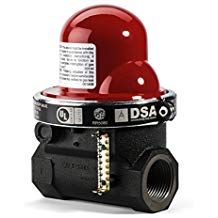Earthquake and Excess-Flow Gas Shutoff Valves
 There are a variety of earthquake shutoff valves on the market. These valves detect the shaking of an eathquake and automatically close, cutting off gas to the house, eliminating the risk of fire from leaks caused by the shaking. One of fthe most highly rated producst is the “California Valve.” There are some lesser-known options out there, but further talks convinced us that the California Valve is probably the best choice, with the "Little Firefighter" also highly recommended. We were lucky enough to find Carl Strand, who is on the committee that wrote the latest ASCE 25-06 standard, “Earthquake-Actuated Automatic Gas Shutoff Devices (25-06).” Disclaimer, Carl is also involved in the manufacturing of the California Valve now. But this seems to be a good thing, rather than a conflict of interest.
There are a variety of earthquake shutoff valves on the market. These valves detect the shaking of an eathquake and automatically close, cutting off gas to the house, eliminating the risk of fire from leaks caused by the shaking. One of fthe most highly rated producst is the “California Valve.” There are some lesser-known options out there, but further talks convinced us that the California Valve is probably the best choice, with the "Little Firefighter" also highly recommended. We were lucky enough to find Carl Strand, who is on the committee that wrote the latest ASCE 25-06 standard, “Earthquake-Actuated Automatic Gas Shutoff Devices (25-06).” Disclaimer, Carl is also involved in the manufacturing of the California Valve now. But this seems to be a good thing, rather than a conflict of interest.
The same valve handles propane and natural gas. There are options for pipe size, and mounting orientation, and there are options to tie the valve into your fire detection system.
If you install in earthquake shutoff valve, you can also install a “customer owned” manual shutoff valve. This means that you can shut off your gas, and turn it on again later, without violating any laws or getting PG&E mad at you. If you do turn your gas back on, be sure you know how to do it safely. PG&E will be happy to do it for you.
These valves must be installed between the gas meter and your home system. Be aware that, when PG&E installed your meter, they also installed the pipe connecting it to your home system. This pipe does not have to meet the code standards of your home system; it could be too small. If that is the case, you will need to install pipe that meets the same code as your home system between the meter and your home. THEN you can put the new valves in that new section. The distinction is whether the gas company considers the new valves to be on your pipe, or theirs. And if you install it on theirs, they can make you take it off.
You can find the California Valve online from many sources. The manufacturer is Pacific Seismic Products.
Here are their products at Amazon.
Regarding excess flow valves, it seems that we should not even think about them for most installations. These valves detect when there is simply too much gas flowing continuously, and shut off. Residential installations, especially, do not need them. In fact, using them in a standard low-pressure residential installation will lower the pressure in your home enough to bring you below code. Excess flow valves are only useful for high pressure systems, almost never found in anything but industrial installations. The exception is excess flow valves that are made for individual appliances. You can put one of these, for instance, on the line to your gas clothes dryer. Consult with a qualified contractor before making any changes to your gas system.